Today, we want to discuss catalytic converter that has a crucial role in a vehicle’s performance and efficiency. This vital component reduces emissions and not only boosts your car’s efficiency but also helps you pass the emission tests. The malfunctioning of the catalytic converter triggers the check engine light.
We’re going to provide some helpful information bout it; including its role, its impact on the vehicle, and the symptoms of its malfunction.
One of the most common symptoms that you detect at first point, is reduced vehicle performance and poor economy fuel usage.
But what can cause the catalytic converter check engine light? In some cases, the faulty catalytic converter smells like a rotten egg and you notice a sulfuric smell from the exhaust. There may also be rattle noises. These signs are discomforting. Moreover, they’re showing there’s a problem with your vehicle that compromises your convenience and threatens the environment. Stay tuned for this article to learn how to deal with this intricate vital.
You might also enjoy: Why Did My Traction Control And Check Engine Light Come On?
Function and Significance of Catalytic Converter
To fix the catalytic converter, you should be familiar with this part that reduces harmful emissions. The catalytic converter is known as under hood environment hero. It’s there to transform harmful gases like carbon monoxide, nitrogen oxide, and hydrocarbons into less harmful ones like carbon dioxide, nitrogen, and water vapor.
There are two existing types of catalytic converter: The two-way converter and the three-way converter. The first one is used in diesel engines and reduces carbon monoxide and hydrocarbons.
The second one, however, is more sophisticated. It’s used in gasoline cars. This catalytic converter transforms carbon monoxide, hydrocarbons, and nitrogen oxide into less environmentally harmful substances.
I realized the importance of catalytic converter roles on vehicles during my long-term hands-on experience in the automotive world.
The converter uses the catalyst. Catalyst is made of precious metals like rhodium, palladium, and platinum. Catalysts are designed to accelerate and facilitate the chemical reactions that release toxic gases.
As soon as you start your ignition, the catalytic converter heats up and catalysts start working. They clean up the exhaust gases before they exit from the tailpipe.
To be able to fix your car and maintain a clean environment, you should have an understanding of the catalytic converters and recognize their types.
The Check Engine Light: A Primer
I’ve faced many car owners struggling with the check engine light during these years. This yellow or orange dashboard light indicates there’s something wrong with your vehicle, however it’s often misunderstood.
The first step in removing this light is to understand its main cause.
The check engine light is a way for your vehicle to communicate with you. It’s like your vehicle asking you for help. However, it’s a bit tricky to diagnose the malfunction that the check light is referring to.
It indicates a range of various issues from a minor issue like a loose gas cap to more serious issues like catalytic converter malfunction or engine failure.
You might also enjoy: Chevy 2500 Bolt Pattern: Ultimate Guide [2023]
How it relates to the catalytic converter
The vital component like the catalytic converter is often overlooked by people. When it fails or malfunctions, the check engine light is triggered. The catalytic converter has a large role in the function of a car’s emission control system.
Various sensors form the onboard diagnostic system of your vehicle. They include sensors like oxygen sensor that measures the amount of oxygen and pollutants in exhaust gases.
If these sensors detect the improper function of the catalytic converter to transform toxic gases into less harmful ones, they send a signal to the computer system. This signal leads to check light illumination.
Many drivers are concerned as soon as they see the warning light on their dashboard. Trust me if they deepen their knowledge about the catalytic converter, they show a different reaction. Because the check light doesn’t always inform you about a disaster.
Sometimes it reminds you to be attentive to your vehicle’s condition. Consider the check light as your friend that warns you about minor issues before they escalate to severe ones. Stick to regular maintenance and be attentive to your vehicle to keep your road companion healthy and in optimal condition.
Symptoms of Catalytic Converter Issues
-
Recognizing the Red Flags
The catalytic converter is a pivotal component in the vehicle as it has a large impact on both the vehicle’s efficiency and the environment. In case of malfunction, some telltale signs arise that each vehicle owner should be familiar with. I provided a list of its symptoms below:
-
Decreased Engine Performance
The first thing that you notice is a significant drop in your vehicle’s performance. Most clients experience it as a vehicle’s lack of responsiveness or sluggish acceleration. This happens due to clogging of the catalytic converter. A clogged catalytic converter leads to exhaust flow restriction and ultimately, engine power restriction.
-
Unusual Sounds
Another symptom of a failing catalytic converter is unusual noises like rattling noises. Once I faced a client who described this sound like a moving box of sands under his car.
I think it was the best description for the failing catalytic converter sound that I’ve ever heard. Remember this sound becomes more noticeable when you’re starting the vehicle or accelerating.
-
Sulfur or Rotten Egg Smell
The sulfur smell that comes from the exhaust is a significant sign of catalytic converter malfunction. You feel this smell due to the inability of the catalytic converter to transform hydrogen sulfide to a smell-less gas of sulfur dioxide. I encountered many clients who were suffering from this awful smell.
-
Check Engine Light
Do you think the check engine light misses an issue like a catalytic converter malfunction? Completely wrong. The check light is triggered as a result of a catalytic converter malfunction.
Mode4n cars have monitoring sensors that inspect the catalytic converter for any issues. As soon as they detect a potential issue, they send signals to the vehicle’s onboard diagnostic system. The onboard system turns the check light on. I advise you not to ignore this warning light as it’s informing you about a problem.
-
Failed Emissions Test
The catalytic converter’s Initial job is to reduce emissions. If it doesn’t function as properly as it should, you face a higher rate of vehicle emissions and this leads to your failure in the emission test. In lots of cases, I found out that the cause of the failure in the emission test was the failing catalytic converter.
Personal Experiences and Solutions
It’s worth mentioning that sometimes these symptoms overlap with another issue but in case of referring to a catalytic converter, make proper interventions as soon as you can. To determine the solution, you need to assess the situation as each condition requires a unique solution.
Potential repairs involve cleaning the catalytic converter, replacing it, or detecting the underlying issue like incorrect fuel mixture. Regular Maintenance and checkups are helpful to be informed of these issues before they put you in trouble on the road.
You might also enjoy: Everything You Need to Know About Mazda Check Engine Light
Common Causes of Catalytic Converter Failure
-
Understanding the Culprits Behind Failure
Throughout years of experience with various vehicles and dealing with many complexities, I faced with catalytic converter issues many times. According to my real-life cases, I suggest you figure out the cause of the problem before heading to fix it. Knowing the reason helps you prevent similar issues in the future.
-
Contaminants in the Engine System
This is the most repeated reason for faulty catalytic converters.
Contaminants are there as a result of oil or coolant leaks to the combustion system. For instance, once I had a case in the car that had worn valve seals, and because of this, it was burning oil. This oil burning led to oil leaks into the combustion chamber. This phenomenon compromises the converter’s efficiency and longevity.
-
Physical Damage and Wear
Typically, internal components of the catalytic converter may break or be damaged due to road debris and time passage. Once I had a client who hit a deep pothole and faced a damaged catalytic converter. As a result of similar issues, the catalytic converter either fails immediately or lessens its efficiency.
-
Improper Fuel-to-Air Ratio
Detecting this issue is a bit trickier than others. In case of more fuel, the engine runs rich and in case of more air, the engine runs lean.
Both conditions lead to incomplete combustion. As a result, the catalytic converter is under excessive strain to work harder and provide more hydrocarbons. This increases the risk of catalytic converter premature wear and tear. This issue can be inspected and prevented in regular check-ups.
-
Poor Maintenance Habits
Proper maintenance has a key role in the performance of catalytic converters. For instance, if you ignore a clogged air filter or a failing oxygen sensor affects the air-fuel mixture. This pits extra strain on the catalytic converter and leads to its wear and tear.
Preventative Measures and Maintenance Tips
-
Regular Vehicle Check-Ups
Stick to regular maintenance as it has a key role in preventing issues and fixing them before they become a disaster. Regular check-ups include checking for leaks and inspecting the sensors to ensure they’re in good condition. Moreover, consider making interventions in case of necessity.
-
Using the Right Type of Fuel
Keep in mind that it’s important to use high-quality fuel. Low-quality ones are full of debris and lead to catalytic converter clogging. To ensure there would be no problem, use the recommended type of fuel by your manual or mechanic’s recommendation.
-
Immediate Attention to Engine Warning Signs
Each car owner should be attentive to the engine’s behaviors. Pay attention to warning signs like the check engine light or telltale symptoms of a faulty catalytic converter. In case of facing with warning, check your vehicle to figure the issue out or seek professional help if you’re in doubt.
Due to the high cost of catalytic converter replacement, it’s a better and more cost-effective option to take preventive steps for it rather than trying to fix it. Finally, be attentive and responsible to your vehicle to ensure your on-road safety and convenience.
You might also enjoy: Why is the check engine light flashing when accelerating?
Diagnostic and Repair Processes
Navigating the Diagnostic Maze
As a result of working under various car hoods, I Gained valuable knowledge about vehicle components, especially the catalytic converter. Stay tuned if you want to learn how to diagnose and fix catalytic converter issues.
Step 1: Visual Inspection and Symptom Analysis
As a first step, consider checking the catalytic converter visually. You should look for significant signs of cracks or damage to the catalytic converter of its surrounding components. Sometimes you find deep grooves on it that occurred as a result of an unnoticed accident with road debris. Once your visual inspection is done, pay attention to the symptoms. Persistent rattling noise, efficiency drop, and rough idling are signs of a faulty catalytic converter.
Step 2: Utilizing Diagnostic Tools
Now, it’s time to refer to modern tools like an OBD2 scanner. Modern vehicles are equipped with an onboard diagnostic system that shows error codes of the existing issue. So we can figure it out by reading those codes. Each code is unique for a specific issue so we can easily pinpoint the main cause.
Step 3: Conducting Performance Tests
It’s also common to take some performance tests. For instance, we test the converter’s back pressure to make sure the gases are moving freely in the catalytic. In case of excessive back pressure, the converter is clogged. Moreover, we take emission tests to see if the vehicle’s pollutants are beyond the standard level or not.
Repair and Replacement Options
After diagnosing the issue, we can take proper repair approaches. For resolving the catalytic converter issue we can either clean it or replace it. Cleaning works in cases of clogged catalytic converters with residues and replacement is the only option for physically damaged or worn-out catalytic converters.
Choosing the Right Replacement
In case of replacement, it’s necessary to choose the proper parts. I always recommend my clients use original equipment manufacturers because they’re designed specifically for various vehicle models. However, you can have a budget-friendly option of aftermarket parts but remember that it should meet emission standards.
As the catalytic converter is a pivotal component, you’d better assess both short-term and long-term consists before going for an option. Consider it as an investment and if you afford it, use high-quality parts because, in the long run, it proves its efficiency and high performance.
To overcome the processes of diagnosis and repair of catalytic converter, you should be precocious, patient, and expert in the mechanical field. We mention these steps for our clients to help them keep their vehicle in its optimal condition. Remember that your car is your companion and to be happy, you should keep your companion satisfied.
Personal Insights and Tips
My several years of working in a help center, made me encounter cases that deepened my knowledge and skill and also taught me proper car maintenance.
My game-changing experience happened when a client entered my shop dissatisfied with decreased fuel efficiency and triggered a check light. With the assumption of it being minor, she didn’t pay attention to it first. I inspected the car and it turned out that the issue was related to the catalytic converter. Her delayed attention and lack of attention to early signs led to further damage and costlier repair.
The Importance of Timely Action
The last example emphasizes timely action. It’s necessary to make interventions as soon as you witness the early signs of an issue. In case you don’t, you will have to suffer from more damage and pay more money for repair. Even the issue may compromise your safety.
You might also enjoy: Water In Engine Oil: Do These 5 Things Immediately [2024]
Conclusion
In brief, it’s necessary to be familiar with the role of a catalytic converter in your vehicle, its signs of damage, and available options for repair. This knowledge empowers you to detect issues in the early step and seek professional help when the issue doesn’t escalate into a disaster. Also, don’t consider regular maintenance as a recommendation. It’s a necessity. You have to do it to ensure your safety, convenience, and environmental health.
Final Thoughts and Advice
Briefly, I suggest all car owners or car enthusiasts always consider the importance of a properly maintained vehicle. Such a vehicle ensures you your safety, convenience, reliability, and environmental health.
Keep in mind to be attentive to your car performance and take each unusual behavior seriously. Try to deepen your knowledge and sharpen your skills in the automotive field to be able to detect and resolve issues as much as possible. However, feel free to consult with a professional when you’re in doubt about something as the wrong approach can put you in trouble with further and costlier damages.
FAQs
- Can a bad catalytic converter cause a check engine light?
Definitely. It’s one of the common causes of check light illumination as I faced with many in my help center. As modern cars have monitoring sensors, these sensors send signals to trigger the check light if they detect a lack of conversion ability.
- Can I drive with the catalytic converter warning light on?
It’s doable to continue driving with this condition but I recommend you not to do so. Driving with such a car increases the risk of further damage and also harmful emissions. In severe cases, it leads to complete engine failure. So you’d better stop your car and seek professional help.
- Can you drive with a bad catalytic converter?
It isn’t said to be impossible but I recommend you against it. It leads to high fuel consumption, harmful emissions, and dropped engine performance. Also, as a result of its high back pressure, other components like the exhaust system and sensors will be damaged. You’d better address the catalytic converter issue as soon as you can.
- What are the symptoms of a bad catalytic converter?
It involves various symptoms. However, the common ones are increased emissions, reduced fuel efficiency, and vehicle performance. It also includes persistent rattling noise and an unpleasant smell of sulfur that is similar to a rotten egg smell.
- How much does it cost to fix a catalytic converter check engine light?
This question doesn’t have a straightforward answer as the cost depends on the vehicle’s model and your chosen repair method. I mean whether you go for cleaning or replacement. Its average cost is around $950 to $2500. But remember to get a few quotes from different shops before you buy a catalytic converter as it’s quite expensive due to the sophisticated materials used.
- Why is catalytic converter repair so expensive?
Initially, you’re patient with the precious metals that are used in the component. The metals are rhodium, palladium, and platinum. These metals are considered catalysts and have a major role in converting gases. As the cost of these metals is high, the catalytic converter has a high price as well. Also, the replacement process of the catalytic converter is daunting and extensive and it adds to your final bill.
- What happens if you don’t fix the catalytic converter?
In case of ignorance, you face many problems and the first one is reduced vehicle performance and poor fuel efficiency. As the time passes, the engine will completely fail due to catalytic converter clogging. A faulty catalytic converter also leads to your failure emission test. These tests are obligatory in some regions with restrictions. Ultimately, it damages your whole exhaust system due to the high pressure of its back. It puts you in trouble with costly repairs.
Finally, consider addressing the catalytic converter early to Save your time, and money and ensure your on-road safety and convenience.
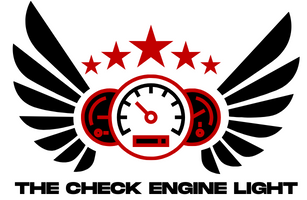

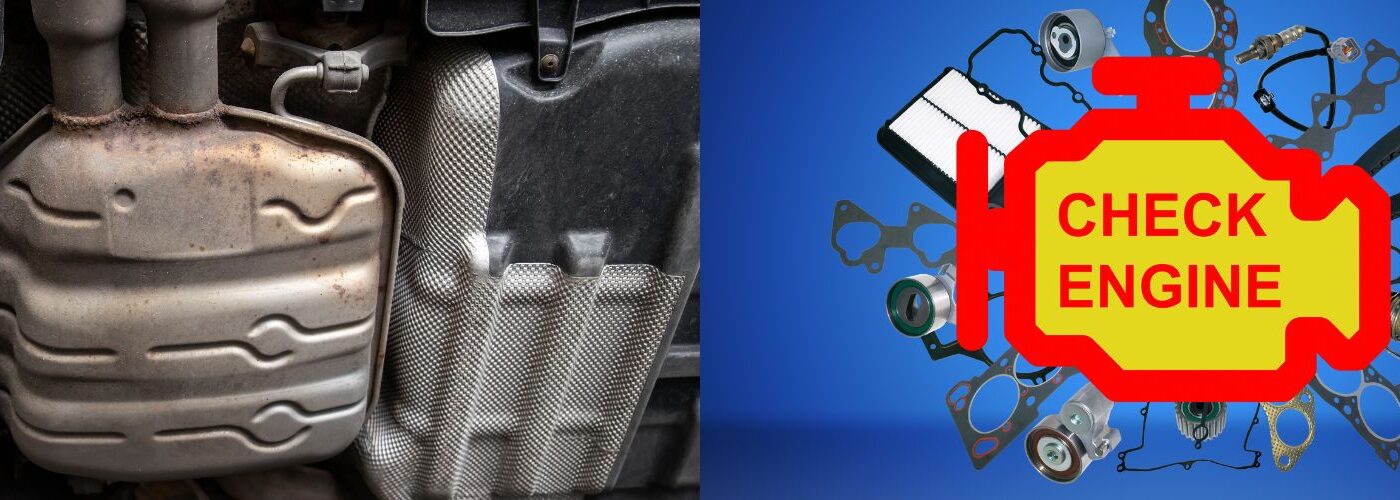
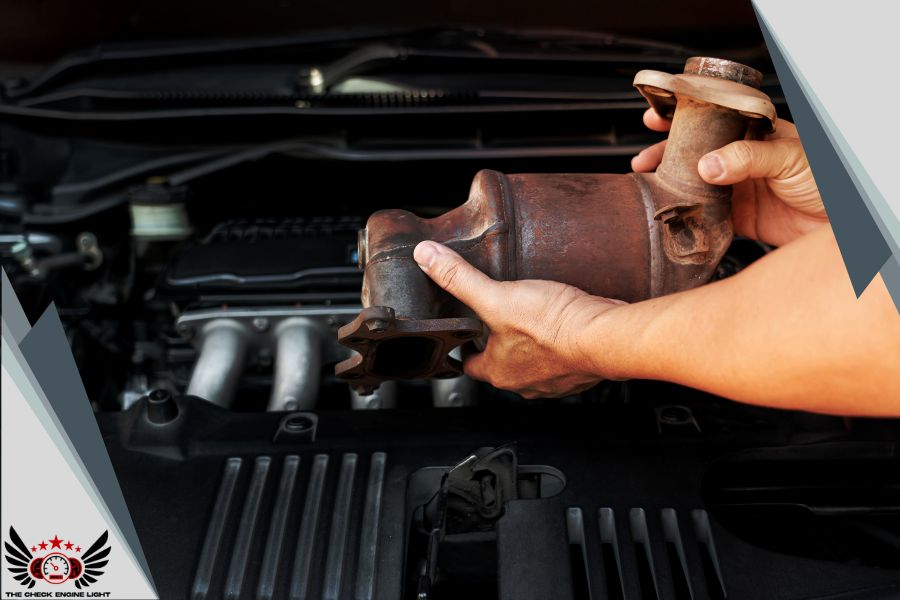
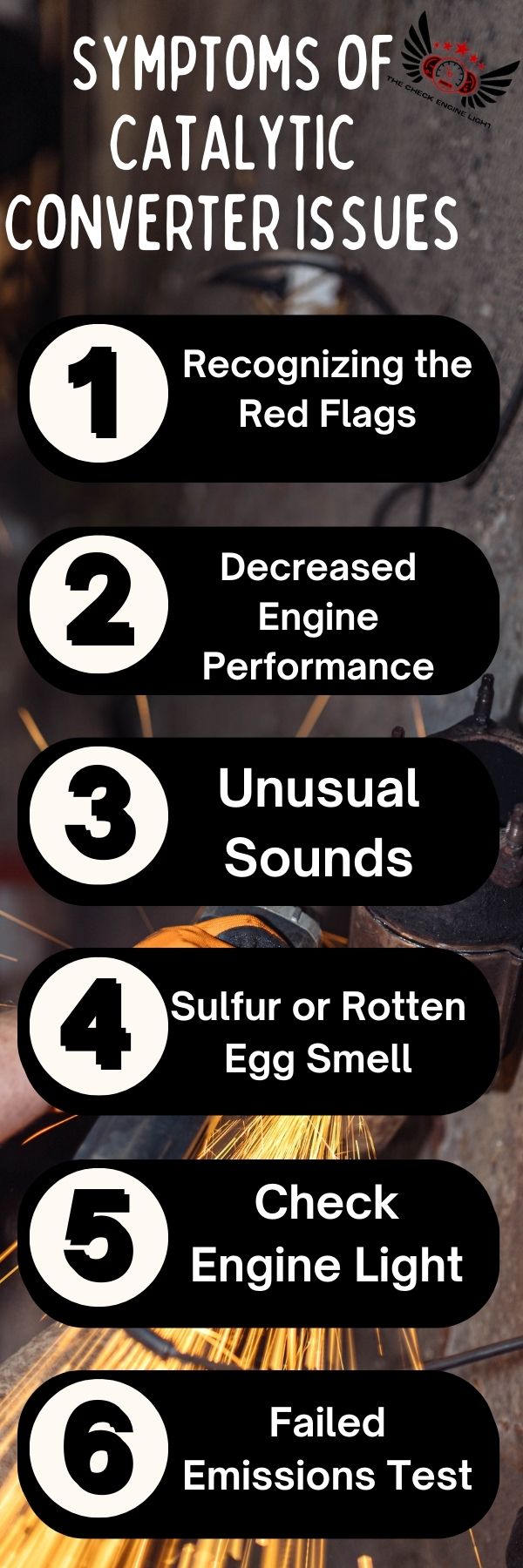
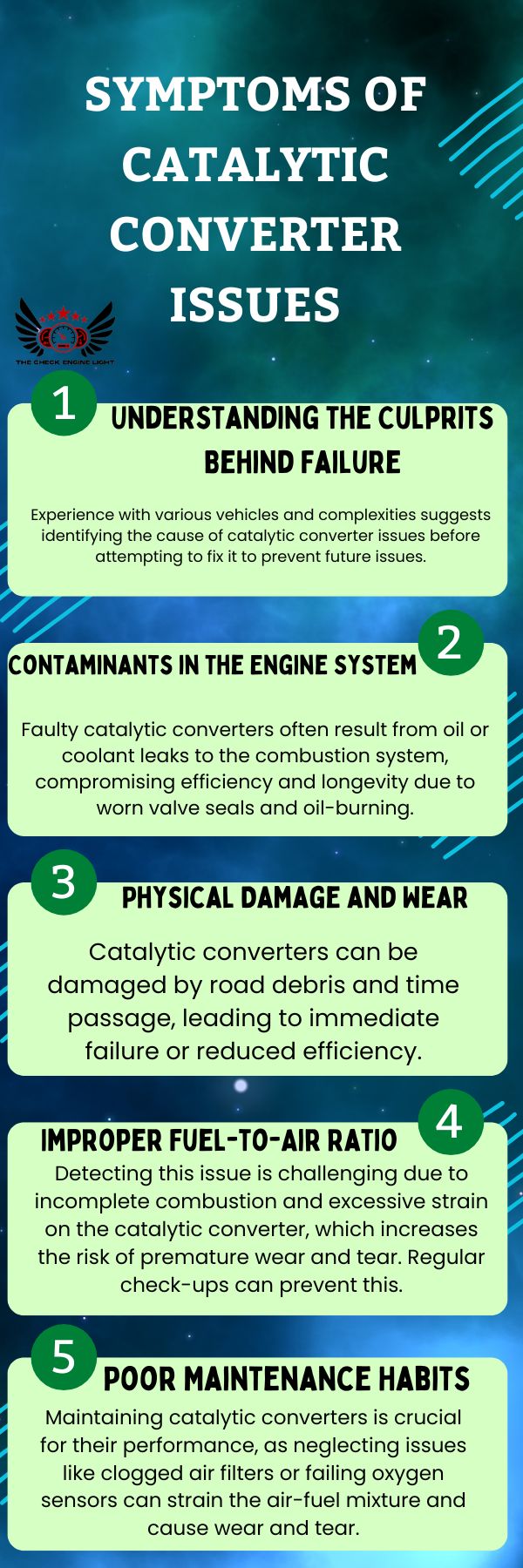
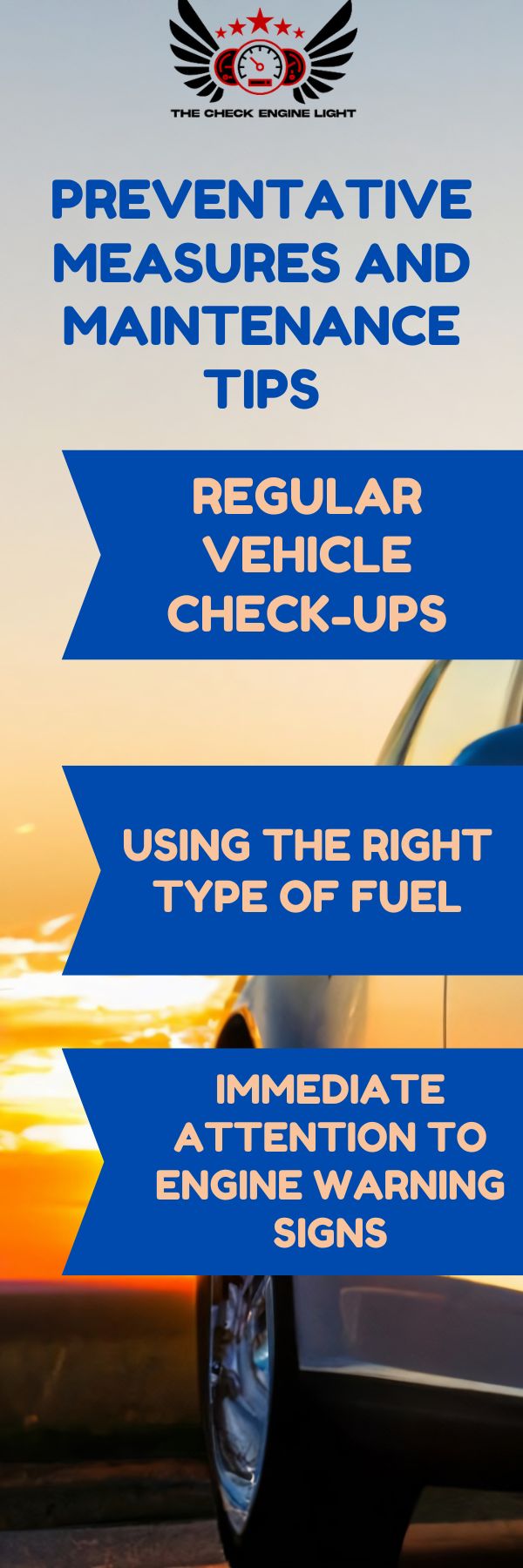
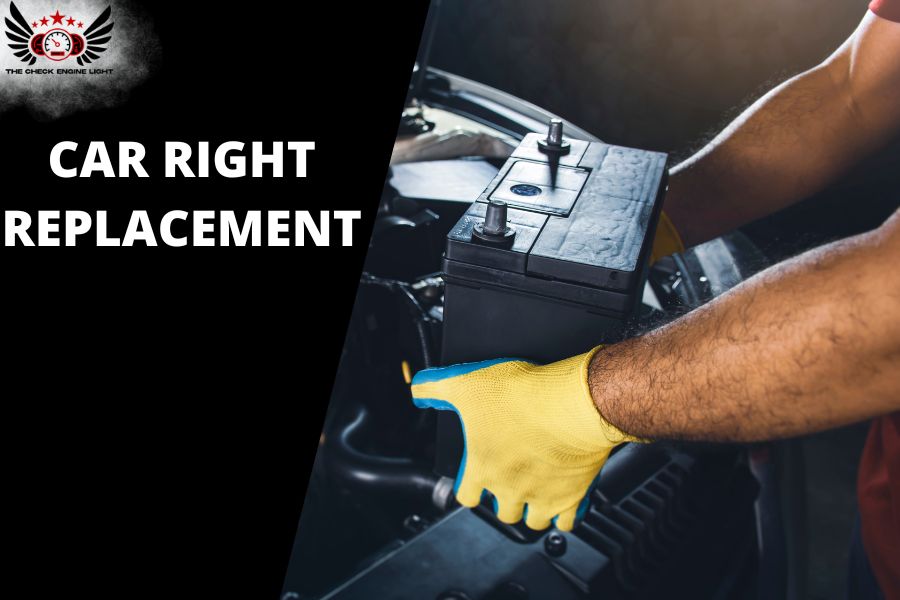
![an pic for Code p0420 Check Engine Light Fully Explained [2024]](https://thecheckenginelight.com/wp-content/uploads/2024/02/Code-p0420-Check-Engine-Light-Fully-Explained-2024-364x225.jpg)

